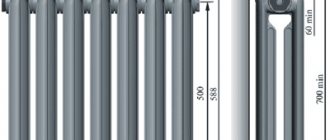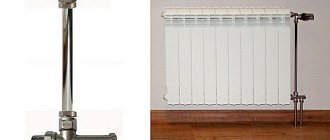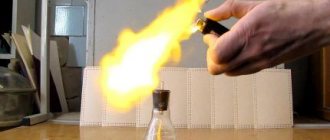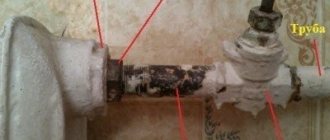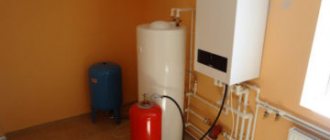Heating system plumbing fixtures are an integral part of any living space. A comfortable microclimate depends on them. According to regulatory documents, maintenance and repair of this equipment is carried out in the spring and summer, when the coolant supply stops. But sometimes unforeseen circumstances arise, and urgent replacement of heating radiators is required during the heating season.
Reasons for replacement
Traditional cast iron batteries have a service life of 30 to 40 years for closed systems and 15 to 30 years for open systems. Often in apartment buildings they have been standing since the times of the Soviet Union. When heating devices run out of service life, they can no longer provide the necessary heat transfer, and sometimes stop functioning altogether. Such radiators must be replaced with new ones, even if it is winter outside.
Another reason when further operation of the battery is impossible is an emergency situation, during which it turns out that the plumbing fixture cannot be repaired.
These include:
- large crack;
- a piece of the section broke off;
- The thread is rusted through.
In this case, the device needs to be changed.
Summarizing
Replacing radiators is a completely feasible task for anyone, even a non-specialist. To do this, you just need to follow the proposed recommendations (and do not forget about the legal side of the issue - for residents of multi-storey buildings). The result will be no different from the work of a specialist, and an additional bonus will be the savings of several thousand rubles.
The video in this article shows the process of replacing a cast iron radiator.
Did you like the article? Subscribe to our Yandex.Zen channel
Rules for turning off batteries in winter
To carry out work, the homeowner writes an application in two copies to the Housing Office (Housing and Operations Office). After a visit to the organization, the applicant’s document must contain the date of reception and a legible signature of the employee who accepted and registered the application. This may be needed in the future if the case goes to court.
Some residents do not want to contact the housing office and turn to third-party companies. However, you should know that, according to the law, such work must be approved by the management of the operating organization. Amateur activity is unacceptable here.
By installing an additional radiator, you can disrupt the operation of the entire heating system, which, according to the project, is calculated separately for each apartment building, including many technical parameters.
Among them:
- nominal power;
- coolant volume;
- working environment temperature;
- diameter and length of pipes;
- number of shut-off valves and connected consumers.
Therefore, in addition to permission to carry out work by the contractor, you will need a document confirming the ownership of the housing and a registration certificate for the apartment. If new equipment is purchased by the residents themselves, copies of certificates not only for radiators, but also for all components: pipes, shut-off valves, fittings are attached to the application.
Who should change the battery
Replacing heating batteries in an apartment in winter can be done either by the housing office or with the help of a contractor, which can be offered by the owner of the property or the management company (Management Company). In any case, the service will be paid. An exception is for apartments in which residents live under a rental agreement, but even there the radiator is included in the common property of the house only if there is no shut-off valve on the pipe running from the riser to the heating device.
The replacement operation can be performed independently if you have experience and appropriate skills. To do this, you will need to write an application to the management company or housing office about the need to turn off the riser and drain the coolant from it. Upon completion of the work, another request for technical expertise is written.
How to get permission
According to Russian legislation, any actions related to the heating system must be carried out by an organization that has the appropriate license. The owner’s task is to find such an organization or contact the housing office with a request to replace the battery by the operating organization. This process, as practice has shown, is onerous.
It sometimes takes up to two months to review the submitted documents (application for replacement of an appliance, copies of certificates for plumbing equipment, certificate of registration of housing rights), so you should be patient, and most importantly, have a registered document in your hands, with the date of application stamped and signed the person who received it. Once permission is received, work can begin. If the Criminal Code or Housing Office refuses to issue a permit, you can go to court.
When replacing the battery with a third party, you will need:
- application for replacement of the device;
- certificate of ownership;
- registration certificate for the apartment;
- thermal calculation (when installing additional equipment or expanding sections);
- certificates for components;
- request for technical examination after completion of work.
Some interesting tips
If you decide to replace old batteries, it won’t hurt to think about installing a faucet, either regular or with a thermal head. In the first case, you can manually regulate the coolant flow, in the second, this will be done automatically. But if a thermostat is installed on the radiator, it does not need to be covered with a decorative screen.
The thermal head on the shut-off valve makes it possible to change the amount of coolant so that the temperature in the room is always high enough
This will lead to data distortion when measuring temperature. It is worth noting that thermostats can only be installed in single-pipe systems. In any case, at least shut-off valves must be installed at the inlet and outlet of the radiator, if they are missing.
This will allow you to disconnect the radiator from the system to clean or replace it, regardless of the season. The thermal power reflected in the battery data sheet does not always correspond to the declared one. If you increase the number of sections by 10%, you can improve the situation.
How to choose the right radiator
There are only 2 fundamental criteria: design and heat transfer. In terms of the second indicator, cast iron batteries remain unsurpassed, although aesthetically they look unattractive. But in modern stores you can also find artistic cast iron. Such devices are heavier than conventional ones, but they also heat better, and they don’t care about water hammer (sharp pressure drop), and besides, they look beautiful.
There is a growing popularity of bimetallic radiators, which perfectly resist corrosion and fit harmoniously into almost any interior. Manufacturers offer both wall-mounted and floor-mounted options. Such devices are connected using polypropylene pipes, the service life of which is 50 years. Elegant products look beautiful and last a long time.
To make the indoor microclimate comfortable, you will need to perform a simple calculation. First, the number of connecting devices is determined. For example, the area of the room is 20 square meters. m. To heat every 2 meters, there is 1 section and 1 additional section for the entire room: 20: 2 + 1 = 11. A cast-iron device with so many elements will look cumbersome, a bimetallic one will look quite nice. But, if there are 2 windows in the room, it is better to place 2 batteries under them for 5 and 6 sections - this is the optimal solution.
Next, the amount of heat is calculated. It is different for each type of house.
The norm for heating one cubic meter of room is:
- for new buildings - 20 W;
- for brick buildings - 34 W;
- for panel buildings - 41 W.
Therefore, for the calculation it is necessary to know the heat transfer of one section. Let it be 100 W. We consider the volume of a room with an area of 20 square meters. m: 5 × 4 × 2.5 (ceiling height) = 50 m³. Let's say this is a new building. Then to heat the room you will need: 50 × 20 = 1000 W. We have 2 radiators with a total number of sections of 11. We multiply them by one hundred and get the result: 11 x 100 = 1100 W with the required 1000 W. Two batteries for 5 and 6 sections are quite enough to maintain a comfortable microclimate. Provided that there are no heat leaks through doors and windows.
Prices for heating radiators from different manufacturers
heating radiators
What tools and components are needed for the job?
Sectional radiators consist of a set of adapters, a plug, and an air vent. The adapters have paired threads: right and left. 1/2 or 1/4 inch internal thread. One set is purchased for each radiator. Before choosing components, determine the diameter of the pipes. It must match the size in the radiator. If these are polypropylene pipes, choose half-inch kits.
Accessories:
- return valve;
- reinforced pipes;
- PPR pipe 20 mm for connection to the neighbor’s heating system;
- manual angular adjustment valve;
- blind and 2 pass-through plugs;
- brackets;
- key for sectional batteries;
- set of plugs and gaskets;
- thermostatic valve;
- eccentric.
Tools:
- adjustable wrenches;
- drill;
- Bulgarian;
- roulette;
- level;
- gas soldering iron;
- for dismantling gas key No. 3;
- tow, winding, sealant.
On a note!
To solder plastic pipes you will need a soldering iron. Before installation, prepare a connection diagram, it indicates all the necessary components.
Radiator replacement
This operation is very important, especially if it is performed in winter, because all floors of the entrance along the disconnected riser remain without water. Therefore, careful preliminary preparation is carried out. If not only the battery is changed, but also the pipes, all measurements with the manufacture of new parts are made before the water is turned off. At this point, everything should be prepared: equipment, components, special tools.
The work is carried out in several stages:
- Stopping the coolant supply. In the basement of the house, the valve on the riser is closed. The water is drained.
- Removing the old radiator. To do this, unscrew the threaded connections, but sometimes they become sour and do not give in. In this case, they are heated with gas or a part of the pipe is cut off with a grinder (alternatively, an acetylene cutter). In order not to damage the paint or wallpaper on the wall, asbestos fabric is first hung on it. The released device is carefully removed from the brackets.
- Hang up the new product, placing it in the horizon according to the building level. The system is assembled with preliminary adjustment using welded and threaded connections. To seal the latter, tarred flax and FUM tape (fluoroplastic sealing material) are used.
- A Mayevsky tap is inserted into the end of the battery's upper plug-plug, having previously drilled a hole for it and cut a thread. In some connecting devices it is installed as standard.
With proper preparation, the work to replace the radiator takes about an hour.
Starting the system and checking its tightness
Before the circulation of the working medium is restored, the battery is disconnected from the system using shut-off valves. Then open the valve in the basement on the riser. When water fills the pipes, slowly (to avoid water hammer) turn the radiator shut-off device flywheel. Then, just as carefully, open the Mayevsky tap, through which the air will escape. You need to close it as soon as coolant appears, signaling that there is no longer an air lock.
After this, the threaded and welded connections are carefully inspected for leaks. In this regard, winter replacement of the connecting device is very convenient, because the system is under pressure and any flaw will be immediately visible. The heat transfer efficiency of the replaced area is also easily determined.
Non-standard situations
An unpleasant situation can happen when, when dismantling cast iron batteries, the bottom of the plug breaks off and the thread remains inside.
Proceed as follows:
- the collector is heated;
- put a chisel to the part in the direction of unscrewing it and try to turn it with a hammer;
- As soon as the edge of the thread is stuck out, it is turned out with pliers.
It is often necessary to remove old rusty batteries in which the threaded connection is corroded or even perforated.
In this situation, you need to do the following:
- “arm yourself” with a coupling made of brass or cast iron of the required diameter;
- cut off the thread from the liner, but leave the first five turns;
- drive the thread with a die;
- wrap the threads with plumbing linen soaked in paint (organic solvent), which dries quickly;
- screw on the prepared coupling;
- Now the wound thread is screwed into the coupling, and the problem is solved.
Useful tips
Regarding rental housing, the picture is unclear. Thus, according to Government Decree No. 491 of August 13, 2006, heated elements are included in the common property of the house. A Art. 65 of the Housing Code of the Russian Federation states: the landlord is obliged to monitor the proper condition of common property and repair it as necessary. In fact, management companies and housing offices carefully hide this information, encouraging residents to replace heating devices at their own expense. Those who wish to assert their rights can apply to the court. But there is certainty regarding privatized apartments. There, the repair of utility networks is the responsibility of the owners.
If the radiator bursts, you must immediately call the operating organization (UK or Housing Office). In some entrances you can find a telephone number on the wall to call an emergency team. The second thing you need to do before the repairmen arrive is to localize the leak (throw a blanket over the battery) and try to collect the water in a placed container (basin). The third step is to turn off the water. If there is no shut-off valve in the apartment, you will have to turn off the entire riser in the basement, the key to which is usually kept by the plumber on duty. Read about the cast iron heating and cooking stove on our website.
When is the best time to do this?
Of course, if the radiators start leaking, there is no time to think about it - you need to start replacing it right away. In other cases, you should focus on the heating system.
Most Russian houses are equipped with a riser system - the same pipe that runs from floor to ceiling in each apartment and is sometimes partially hidden in the walls. If during the heating season the batteries are periodically turned off because the neighbors have started repairs, then the house definitely has a riser system. In this case, if it does not burn, it is easier to postpone the replacement to the period from May to September, when the heating is turned off and the process will not cause inconvenience to other residents.
Some new buildings use a different system - apartment heating. This means that the riser is located in the entrance and on each floor there are separate pipes leading from it to the apartments. The plumber can shut off the water supply to the radiators directly at the collector in your hallway, while heat will still flow to your neighbors. Thus, when installing apartment heating, batteries can be replaced at any time.

